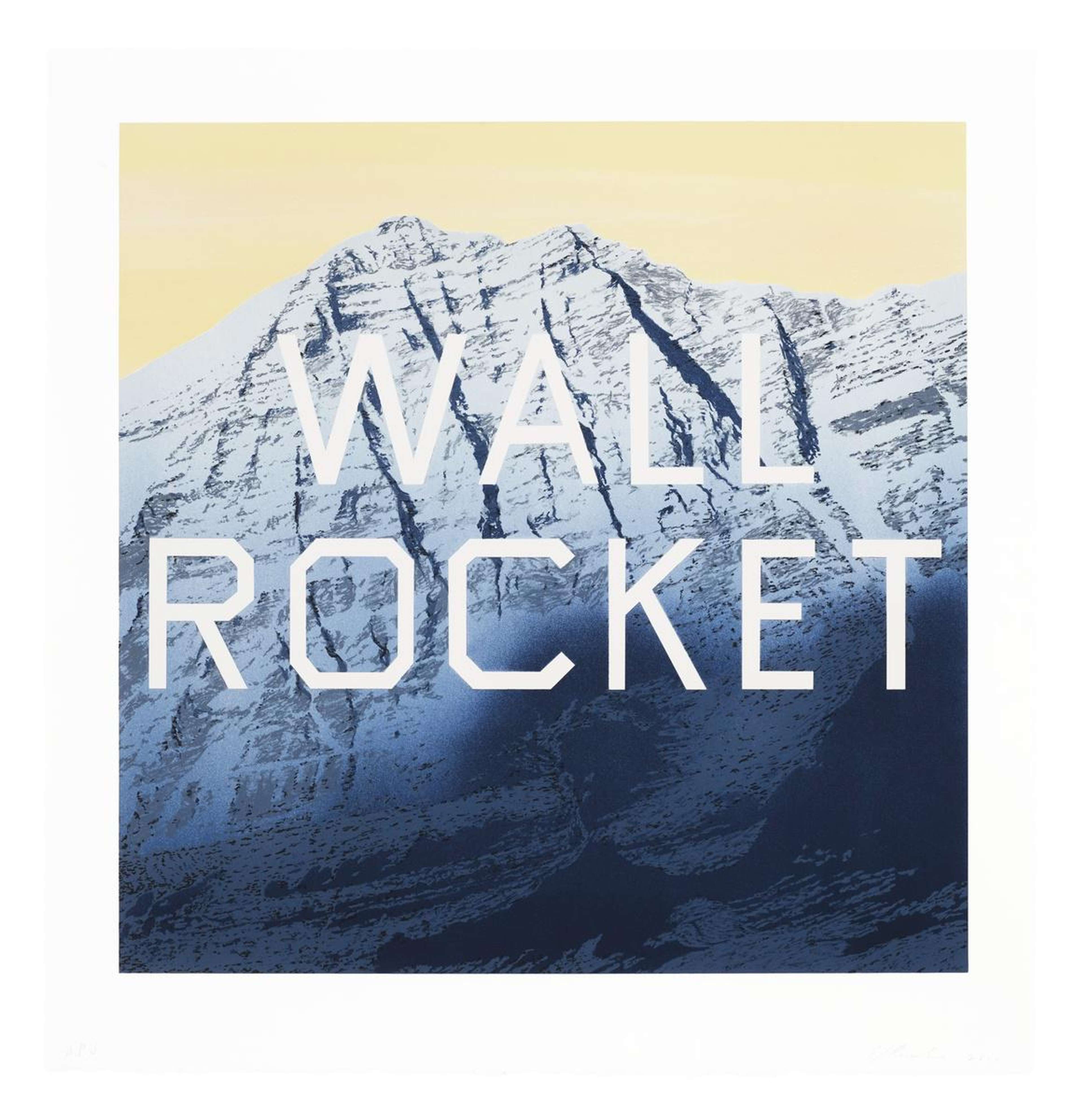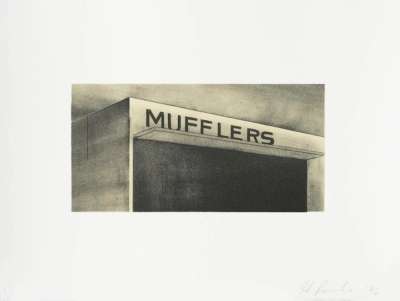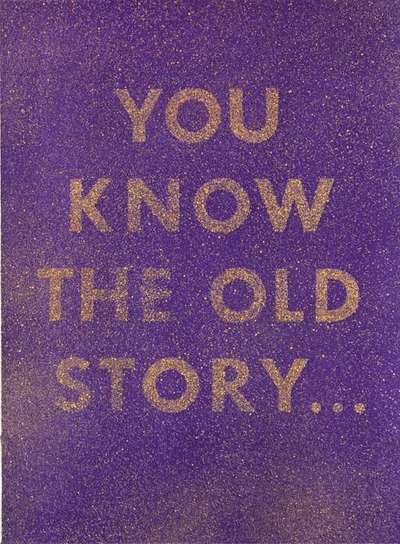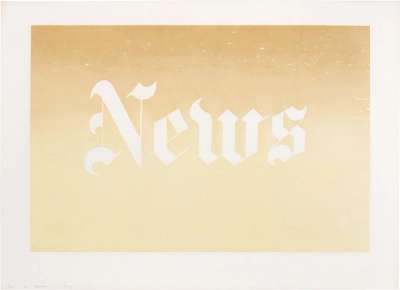The Impact of California on Ed Ruscha’s Artistic Vision

 Standard Station © Ed Ruscha 1966
Standard Station © Ed Ruscha 1966
Ed Ruscha
248 works
Key Takeaways
Ed Ruscha's artistic vision is profoundly shaped by California's landscapes and urban environments, and the city's architecture and sprawling urban scenery became key elements in his iconic visual language. Ruscha's art, which blends text, imagery, and commentary on American culture, often reflects the stark beauty of California's deserts and the complexities of its urban life. His innovative use of text and photography has left a lasting impact on contemporary art, solidifying his legacy as a pioneering figure.
Ed Ruscha stands as one of the most influential figures in contemporary art, particularly within the realms of Pop art and Conceptual art. His work is characterised by a distinctive blend of text, imagery, and a deep engagement with the vernacular of American landscapes, his depiction of resolutely ‘all American’ iconographies serving as a commentary on US culture. California is not merely a backdrop in Ruscha's art, but a central force that shapes his vision, this visual language dominating his photography and paintings.
Exhibiting alongside Pop art icons Andy Warhol and Roy Lichtenstein, Ruscha’s artworks are celebrated as some of the most iconic symbols of contemporary American visual culture.
Early Life and Move to California
Background and Early Influences
Born in Nebraska, in 1937, and raised in Oklahoma City, Ruscha was initially drawn to art through his adolescent interest in comics, graphic design, and typography. His early influences were shaped by the Midwestern environment, a region steeped in the imagery of post-war America. However, it was Ruscha’s move to California in 1956, with its promises of new opportunities and cultural vitality, that had a lasting impact on Ruscha’s art.
Settling in Los Angeles
Rusca’s move to Los Angeles in 1956, to attend the Chouinard Art Institute, marked a significant turning point in Ruscha's life and career. The city’s urban landscape, characterised by its geometric apartment buildings, boundless freeways and gas stations, had a profound impact on his developing artistic style. Los Angeles, a vast, decentralised metropolis, offered Ruscha a wealth of visual and cultural stimuli. Early experiences, such as road trips along the Pacific Coast Highway and explorations of the city’s diverse neighbourhoods, provided him with a rich visual vocabulary that would later become his trademark visual lexicon.
California Landscapes and Urban Scenes
The Californian Landscape
California’s diverse landscapes, from its arid deserts to its sparkling coastlines, have been a constant source of inspiration for Ruscha. His art often distils these environments into iconic, minimalist images that capture the stark beauty and vastness of western US landscapes. Works such as Desert Gravure (2006) and Home With Complete Electronic Security System (1982) highlight his fascination with the empty, expansive spaces of the California desert, where the landscape itself becomes a central character. These pieces reflect not only the physical environment of California, but also its symbolic role as a place of freedom, isolation, and contemplation.
Urban Environment
Los Angeles, with its unique urban sprawl, has been a central theme in Ruscha’s work. The city’s architecture, gas stations, and industrial zones are not just background elements, but protagonists in his visual narratives. His work frequently explores the mundane yet iconic elements of city life, imbuing them with a sense of both familiarity and alienation. Ruscha's minimalist approach and use of text juxtaposes the gritty reality of urban sprawl with a detached, almost surreal aesthetic.
Cultural and Social Influences
Pop Culture and Media
California, and particularly Los Angeles and Hollywood culture, are popular focal points of American pop culture. This vibrant scene has deeply influenced Ruscha’s artistic themes, the media and entertainment industries’ emphasis on spectacle and surface, providing Ruscha with a rich tapestry of imagery to explore. Due to his background as a layout artist in the art department of a Los Angeles advertising agency, Ruscha’s works often engage with the language and aesthetics of advertising, Hollywood, and mass media. Works, such as Hollywood Tantrum (1979), playfully celebrate the seductive power of popular culture, whilst critiquing the pervasive influence of these industries on the American consciousness.
California Lifestyle
The California lifestyle, defined by its consumerism, surf culture, and the glamour of Hollywood, has left an indelible mark on Ruscha’s art. His depictions of gas stations, parking lots, and highways are more than just representations of physical spaces; they are symbols of the broader cultural trends that define life in California. The car, in particular, is a recurring motif in his work, representing freedom, individuality, and the fast-paced life of modern California. Ruscha’s art captures the unique rhythm of life in California, where the boundaries between the natural and built environments are constantly blurred.
Innovative Techniques and Mediums
Use of Text and Typography
One of Ruscha’s most significant contributions to contemporary art is his innovative use of text and typography. His primary works, such as OOF (1962) and HONK (1962), showcase his ability to transform simple text into powerful visual statements. From 1966 to 1969, Ruscha painted his ‘liquid words’, including Adios (1967), Steel (1967-9) and Desire (1969) as if the words had been written with aqueous liquid, spilling or dribbling over a surface. Ruscha did not limit himself to singular words, and from the 1970s his pieces underwent experimentation with entire phrases, such as Brave Men Run In My Family (1988), making longer phrases a distinctive characteristic of the post-pop art generation, and bridging the gap between visual art and language.
Photography and Mixed Media
Photography has significantly contributed to Ruscha’s oeuvre, using it not just as a tool for documentation but as a medium for artistic exploration. Having moved to LA, Ruscha would often visit his parents in his home city, driving the 1,400 mile-long journey alone, and becoming entranced with the minimal, streamlined architecture of service stations along the route. Consequently, in 1963 he created his artist book, Twentysix Gasoline Stations, a collection of photographs documenting his gas station obsession. As well as his book, Ruscha produced many iconic photographs detailing his interest in California’s urban landscape, including Filthy McNasty’s (Sunset Strip Portfolio) (1976) and 818 Doheny Drive (1965).
Iconic Works Inspired by California
Standard Station (1966)
An instantly recognisable Ruscha work is Standard Station (1966), which epitomises his focus on California iconography. The painting, with its bold lines and graphic composition, captures the essence of mid-century California’s car culture, a world defined by mobility, consumption, and the open road. Similarly, Rooftops (1961) reflects his interest in the everyday architecture of the city, turning mundane buildings into subjects of artistic inquiry.
Every Building on the Sunset Strip (1966)
Another iconic Ruschapiece is his Every Building on the Sunset Strip (1966), a nearly 25-foot accordian style photographic panorama, documents both sides of a mile-and-a-half stretch of Sunset Boulevard in Los Angeles. This piece, which combines photography, bookmaking, and conceptual art, captures the essence of Los Angeles while challenging traditional notions of what constitutes a work of art.
Hollywood Sign Series
Ruscha’s series focused on the Hollywood sign delves into themes of fame, glamour, and the elusive nature of the American Dream. The Hollywood sign, an enduring symbol of the entertainment industry, becomes in Ruscha’s hands a site of both aspiration and decay. His works such as Hollywood (1968), Pepto-Caviar Hollywood (1970) and Hollywood In The Rain (1970), explore the tension between the ideals that Hollywood represents and the often harsh realities of the pursuit of fame, reflecting broader themes of illusion and reality in American culture.
Impact on Contemporary Art and Culture
Influence on Other Artists
Ruscha’s California-inspired works have had a profound influence on artists due to his innovative use of text, his focus on the banal elements of urban life, and his engagement with the American landscape. His involvement in the Pop art scene has influenced a younger generation of Neo-pop artists, such as Jeff Koons, whilst his single-word canvases have inspired artists, such as Martin Creed, to pursue text-based projects.
Legacy and Recognition
Over the decades, Ruscha has garnered widespread critical acclaim and recognition for his contributions to contemporary art. His works have been featured in major exhibitions and retrospectives worldwide, cementing his status as one of the most important artists of the 20th and 21st centuries.
California’s Enduring Influence on Ruscha’s Art
Ruscha’s artistic vision is inextricably linked to the California landscape, both physically and culturally. His work not only captures the essence of California's diverse environment, but also reflects broader themes of American identity and culture. Through his innovative use of text, photography, and a deep engagement with the vernacular of the American West, Ruscha has created a body of work that resonates far beyond the borders of California. His legacy as a pioneering figure in contemporary art ensures his works will continue to inspire and captivate audiences for generations to come.

































